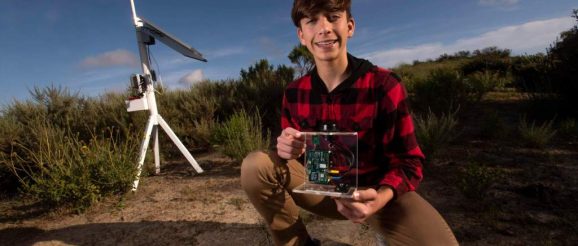Will the next wildfire be prevented by a 14-year-old’s innovation?

Since the fifth grade, Ryan Honary has been developing a technological solution to better detect – and therefore prevent – wildfires, after witnessing the devastation of the 2018 Camp Fire in Paradise.
After years of innovation, including awards and grants for his impressive artificial intelligence-driven concept, the Newport Beach 14-year-old is now getting the opportunity to test his network of sensors in his community’s backyard.
“I’m really excited,” Honary said. “I always talk about it, but I never really had it happen until now.”
In a new partnership, Honary is working with the Irvine Ranch Conservancy, a nonprofit working to preserve natural habitats in large parts of Orange County, to evaluate and pilot his project on the largest scale yet, while also exploring other uses for the technology beyond wildfire prediction and prevention.
-

The remote sensor developed by 14-year-old Ryan Honary in Newport Coast on Friday, April 22, 2022. The sensor integrates with an Intermediate Node and a self-contained mesh network that will help in the early detection of wildfires as well as identifying spread patterns. (Photo: Paul Rodriguez/for the Orange County Register)
-

Holding his remote sensor, Ryan Honary stands next to his Intermediate Node in Newport Coast on Friday, April 22, 2022. (Photo: Paul Rodriguez/for the Orange County Register)
-

Ryan Honary, in Newport Coast on Friday, April 22, 2022. (Photo: Paul Rodriguez/for the Orange County Register)
-

Ryan Honary holds a remote wildfire sensor he developed. (Photo: Paul Rodriguez/for the Orange County Register)
“The concept is solid,” said Nathan Gregory, IRC’s vice president and chief programs officer, who has become a collaborator and mentor with Honary. “Fire is one of our biggest conservation challenges. A big focus of what we try to do is reducing ignition, especially during those windy days.”
While Gregory said testing is still in the beginning phases he is convinced the project could become a game changer for fire prevention, especially in remote areas.
Honary’s technology, dubbed “SensoRY AI,” had previously received multiple grants from the U.S. Navy Office of Naval Research that helped launch a startup for developing the system to get it ready for the real world testing.
Honary, now an eighth-grader at The Pegasus School in Huntington Beach, describes his sensor system as a self contained, wireless mesh network that can communicate heat or smoke information among other sensors and to his machine-learning “mini meteorological stations,” which can then predict fire growth and share that valuable information via an app to fire response teams and the general public.
He’s won multiple national science awards for the project in the last few years, including becoming a Broadcom MASTERS finalist in 2020.
But Honary said seeing his network in action in more realistic tests recently at the IRC’s native seed farm was most exciting for him. Both Gregory and Honary called the first go around at the farm, which has limited cell service, successful and said they are excited to do more remote, larger tests.
“These types of projects and collaborations are what makes my job really fun, when we’re thinking about what’s possible,” Gregory said. “It’s been energizing for me as well. It just has a lot of potential.”
The IRC has been hired to manage about 40,000 acres of wildland, dubbed the Irvine Ranch Natural Landmarks, that are owned by OC Parks, Irvine and Newport Beach. The properties stretch from Weir Canyon near the 91 Freeway through the canyons to the City of Irvine’s Open Space Preserve and Buck Gully Reserve in Newport Beach.
Gregory said he’s also eager to see how Honary’s design and concept could be useful in their conservation efforts in other ways, because of its capability to operate in high-risk or secluded areas, with little infrastructure needed. He said he has ideas for testing soil moisture and water levels, or even allowing them to remotely transfer images and pictures from their wildlife cameras.
“The more we can do and have a lighter touch on the land helps us perform our mission more efficiently and better,” Gregory said. “The sky is the limit. The sensors have the ability to be adapted to almost anything else we are interested in.”
And it’s been cool for Honary to learn how else IRC officials think his technology could further benefit the natural world.
“I’m just trying to be the most help to the environment,” Honary said. “My network can be used for many different applications, just by switching the sensors.”
He said he would love to see his system operate one day in a way that a variety of groups across the globe could monitor a multitude of environmental issues, with some using it for fires and others for air quality, wildlife monitoring or even water pollution – the latter of which he recently became more interested in after October’s massive oil spill off the the coast of Orange County, just down the road from his neighborhood.
Honary said he would love to tweak his system so it could be placed underwater to detect a pipe crack or oil leak far before it becomes an environmental disaster.
“Why are we pondering going to other planets when we still can’t solve problems on our own planet?” Honary said. He said so many environmental issues could be better solved with more proactive measures, which is why he chose to focus his project on early detection.
“This generation has a proficiency with technology,” Gregory said. “Ryan’s coming at it with such an innovative approach. What’s been fun for us, and I hope it’s been interesting for him, (is) how do we bridge that gap between really interesting technology and natural resources conservation.”
“I’m hoping down the road we’ll be able to do some really cool things together,” Gregory said. ” I’m always blown away by people his age that have this kind of talent.”
